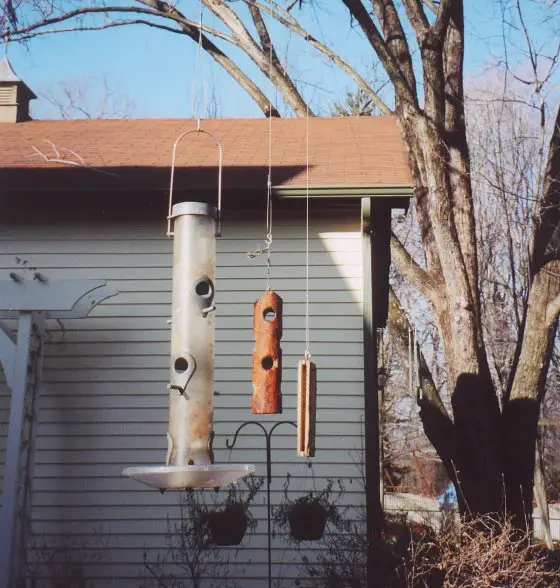Squirrel Proof Birdfeeders

DEAR TIM: I know you build houses but have any customers asked you to solve outdoor pest problems? I love feeding birds but hate the pesky squirrels who have figured out a way to get on every bird feeder I have tried. Some feeders are squirrel-proof but I don't even want the pests on the feeders in the first place as they scare away the birds. Have you or one of your customers ever had this same problem? Do you have any ideas as I am at my wits end. Celia D., Pine Bluff, AR
DEAR CELIA: Believe it or not I have had requests just like this. In fact, my wife asked me to solve the same problem. She loves to feed outdoor birds and I must admit it is very interesting to see the many birds that are attracted to our different feeders. The squirrels that visit my house must be related to your clan as they have always been able to figure out a way to get on my feeders. I have purchased so many squirrel deflectors and shields I could start a museum. But six months ago I finally devised a 100 percent squirrel proff method of hanging bird feeders.
Squirrels are fascinating little animals. They are so industrious and determined. What's more, they are smart. I have watched them study a situation and try different approaches to solve a problem. The are agile climbers that can scale a smooth metal pipe like you or I would climb a ladder. Knowing this made it clear to me that solving the squirrel problem meant the elimination of poles that held my feeders. I decided to try to hang my feeders from a thin wire that crosses over the back edge of my rear patio.
Over the years, I used to watch squirrels walk across utility wires as we ate lunch at different jobsites. Squirrels could easily traverse a single strand wire with or without insulation. But the average high voltage wire is fairly thick and allows the squirrel's feet to get a decent purchase. I decided to experiment with a very small diameter, but exceptionally strong wire.
One visit to my friendly neighborhood hardware store was all I had to do. Once there I found that they stock 1/16th inch diameter galvanized wire rope and two different types of cable clamps. In addition, I purchased two 1/4 inch diameter open hooks. One hook was placed at a corner of my garage and the other hook was placed in the trunk of a massive pine tree about 35 feet away from the garage. To make sure the suspended wire would not be a hazard to anyone walking under it, I decided to keep it about 12 feet up in the air.
The hardware store had U-shaped cable clamps that matched the wire size I was using. These clamps allow you to create a fixed loop at each end of the wire. The clamp has a small nut on each leg of the U clamp. As you draw them tight it squeezes the clamp tightly so the wire making the loops can't slide back through the clamp. The creation of the two sturdy loops allowed me to hang the wire tightly between the two open hooks. For extra insurance I used two clamps at each end of the wire.
The wire is so strong it easily allows me to suspend five different feeders full of food. I used a different style smaller friction clamp to attach 5 foot long pieces of wire for the feeders. The smaller clamps are activated by a hammer blow that flattens the soft metal clamp. It is important that the bottom of a feeder is a minimum of 5 feet from the ground or any nearby ledge, table, flower pot, etc. that a squirrel could use as a launching pad. I have seen squirrels leap vertically nearly four feet in an attempt to jump to my suspended feeders.
You don't need a garage or a tree(s) to achieve what I did. Simply install two 4x4 posts in the ground that are at minimum of 14 feet from one another. Placing the posts much closer than this will tempt a squirrel to jump from the post to a feeder. The tops of these posts should be at least 10 feet out of the ground. Suspend your wire from the tops of these posts. The squirrels will easily climb the posts in an attempt to get to the feeders but watch with satisfaction as they try and try to walk across the thin wire towards an easy lunch.
Column 394